Do you cook paella?
Do you cook paella?
-
-
-
-
-
Do you cook paella?
-
Post #1 - March 30th, 2007, 9:18 amOne of the tricky aspects of paella is getting the right rice, especially if you cook it on the stovetop. That's because as the liquid is absorbed by the rice and as it evaporates, the level of the liquid goes down below the rice at the top of the paella pan quickly. If you use the wrong rice, it is likely to be soggy at the bottom and crunchy at the top. That is bad.
The Spanish have developed terrific short grained rices that absorb liquid quickly and don't get mushy. But they are hard to find, except on the internet, and they are relatively quite expensive. So I've looked around for alternatives. Domestic and Mexican rices labeled Valencia and recommended for paella are not in the same league as the Spanish.
The best I've found is a rice from Bosnia Herzegovina and sold under the Klas brand. Devon Market used to carry it, but doesn't any more. Has anyone else found a quality short grained rice locally?
-
-
Post #2 - March 30th, 2007, 1:58 pmI use a paella to cook rice on a regular basis and prefer to use either top-grade Spanish or Italian short grain rices but for economic reasons I often use others. Goya's Valencia short grain rice is good but it is no longer as easy to find as it was a few years back. La Preferida also sells a Valencia style short grain (also somewhat more difficult to find these days than it once was), which perhaps you've tried; it's serviceable, though of course not as good as the high grade (and more expensive) products from Spain or Italy. The La Preferida product, which we hadn't seen in any of our usual Mexican groceries in a long time, we found at the Caputo's in Addison recently.
AntoniusAlle Nerven exzitiert von dem gewürzten Wein -- Anwandlung von Todesahndungen -- Doppeltgänger --
- aus dem Tagebuch E.T.A. Hoffmanns, 6. Januar 1804.
________
Na sir is na seachain an cath.
-
-
Post #3 - March 30th, 2007, 3:01 pmLike Antonius, I've been fairly happy with the Goya California "Valencia" stuff. I buy mine at La Unica. Granted, it's not bomba, but it has the basic characteristics. It's very very cheap, comparatively speaking. That's some consolation.
-
-
Post #4 - March 30th, 2007, 4:14 pmDarn It!
By the thread title I was hoping to be able to answer with a smartass "Yes, unless you like crunchy, uncooked rice!"
Alas, I was hoping that it was another question, similar to one my sister asked me a few years ago, "How do you cook pasta?" These questions are usually answered with a slap to the forehead, and me walking away with my family honor forever tarnished.
Flip"Beer is proof God loves us, and wants us to be Happy"
-Ben Franklin-
-
-
Post #5 - March 30th, 2007, 5:04 pmI use arborio rice, and I first "toast" the rice in oil on the stovetop, then add liquid and boil (covered) for about 20 minutes before transferring it to the oven. I rarely have a problem with what I'd describe as mushy/raw rice, though this combo cooking method does produce cooked-but-crunchy rice for the pieces that are on the top, near the edges. (I like those sections a lot.)
It's rare that I ever order Paella in a restaurant in the United States. I find it has a tendency to be too greasy, and a bit like rice-a-roni even at allegedly "Spanish" restaurants. Mine is a family recipe that I think originated with the Spanish cook who worked for Mom's family when they lived in Morocco, though it's been modified over the years.
-
-
Post #6 - March 31st, 2007, 2:11 pmI just made a pan for lunch -- an excellent way to use leftover chicken.
I do not use any special rice, but patience is crucial. When I smell that the bottom is browning, it's time to turn off the heat and let it rest. The rice may be slightly underdone at this point, but as it rests, it will continue to soften.
I admit to improvising and adding fluid mid-boil if I suspect that the fluid will evaporate before the rice is nearly done.- Peter
-
-
Post #7 - March 31st, 2007, 5:39 pmFlip wrote:These questions are usually answered with a slap to the forehead, and me walking away with my family honor forever tarnished.
Flip
Right there with 'ya, Flip! To my further shame, I've ruined it with a family recipe of my mother's; and I once ruined a holiday meal I'd volunteered to cook at the firehouse by attempting it in a strange kitchen. ("Paella!" hence became the Uberspouse's nickname)
I should add this to the "Foods I can't cook" thread...
-
-
Post #8 - April 5th, 2007, 8:15 pmLTH,
With Antonius and JeffB's Goya and La Preferida Valencia recommendations and Pigmon and Trixie-Pea's impressive paella at m'th'su's in mind, I stopped at La Unica and picked up rice, both Spanish and Colombian chorizo, chicken, onion, tomato and garlic.
I've only made paella a couple of times at home using thin metal paella pans, which up the skill level but reward with lovely crisp bits of rice, socarrat. Though tonight was my best effort, and my wife and I enjoyed dinner, I have a way to go before I'd serve paella to company.
Steps are fairly explanatory, I will be happy to elaborate if asked.
Saffron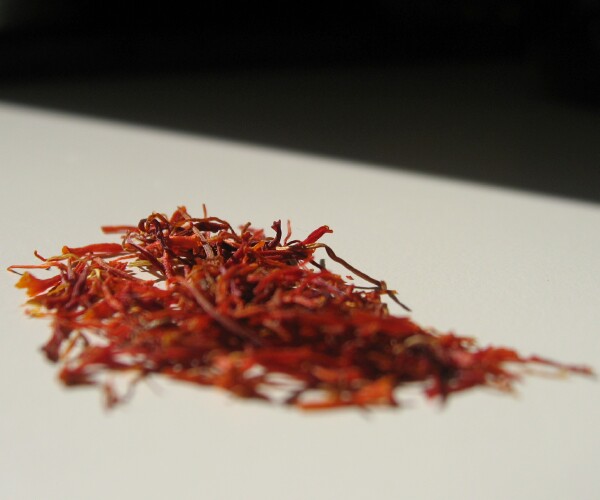
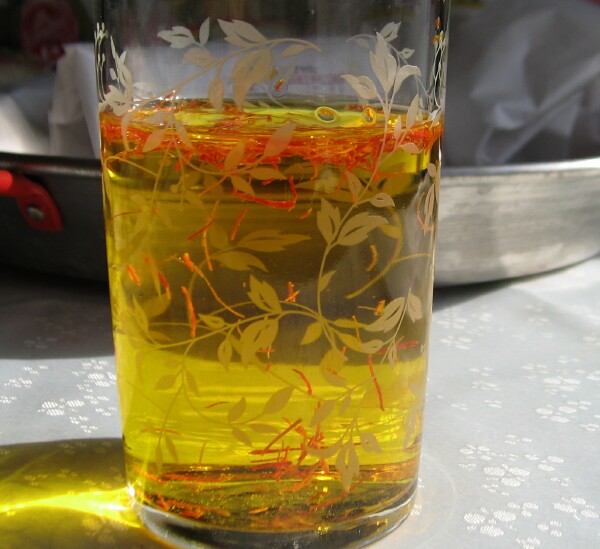
Rice, I used the La Preferida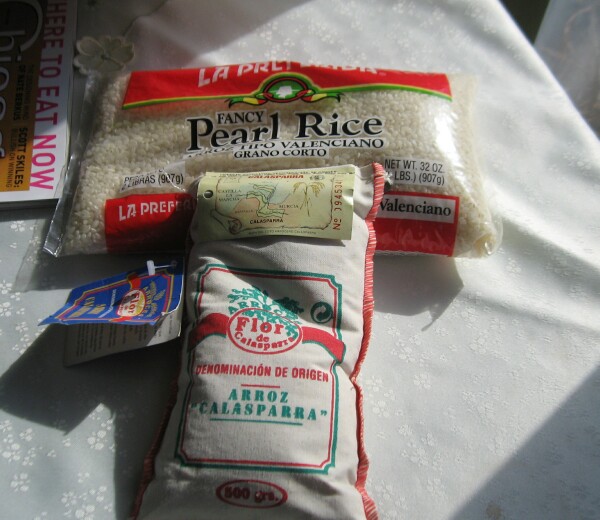
Colombian / Spanish chorizo, tomato, garlic, onion.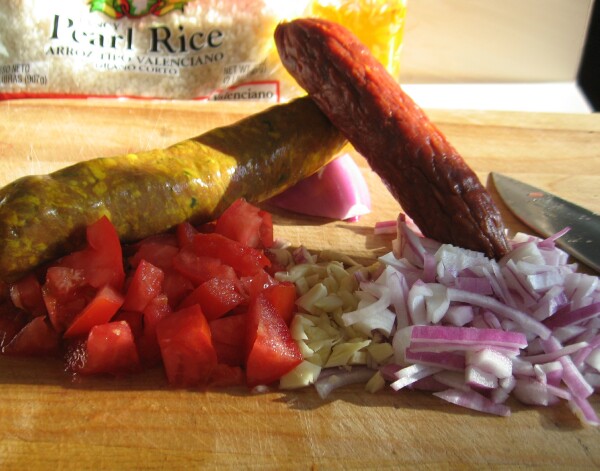
Sautee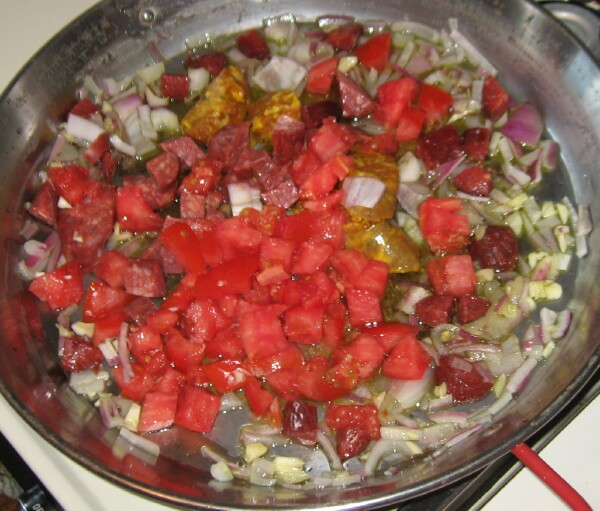
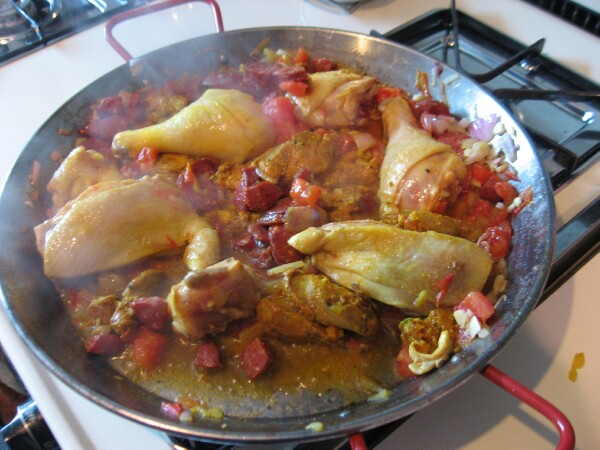
Add stock, bring to a simmer.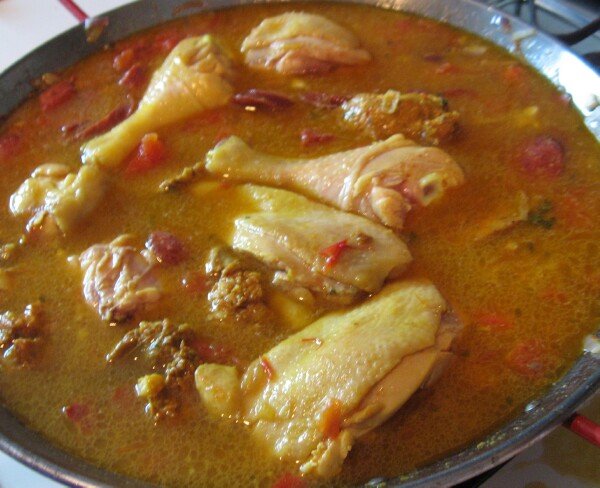
Add rice, continue simmering.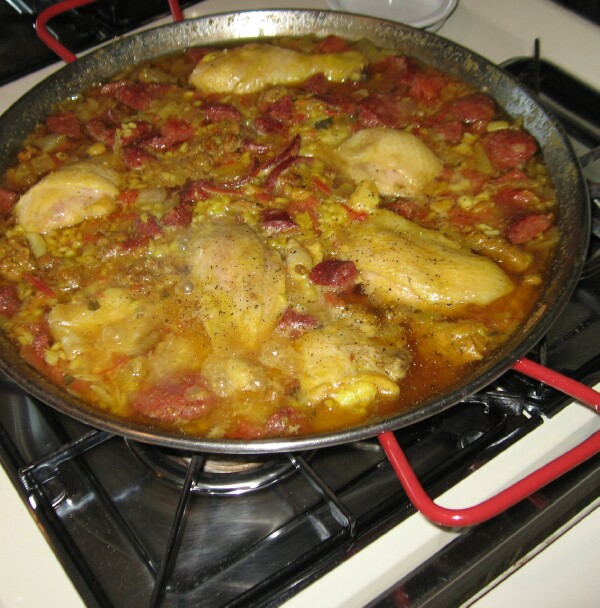
Finished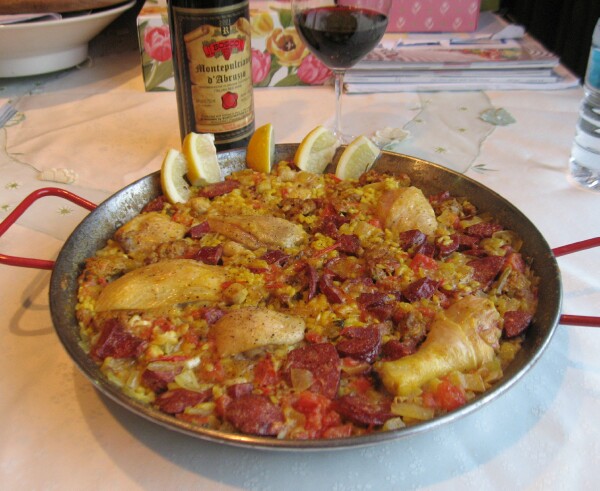
Plated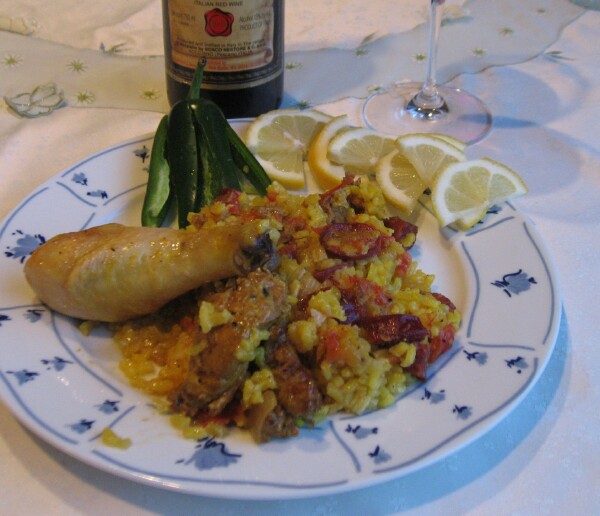
Socarrat (crisp bits), best part of paella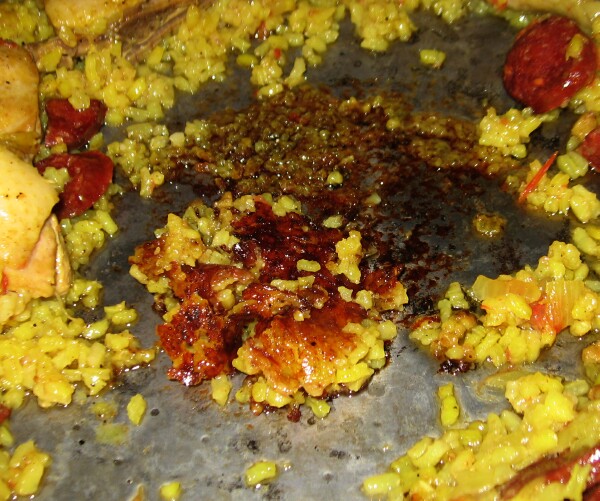
Lessons learned:
Move pan around to different quadrants over the flame helps cook evenly.
Be a little more aggressive with spicing.
Partially degrease pan after sauteing sausage.
Three additional paella threads may be found here, here and here.
Enjoy,
Gary
-
-
Post #9 - April 6th, 2007, 9:48 pmMuch to my wife's dismay I tend to repeat a dish until I have a basic understanding. I wasn't much satisfied with last night's paella effort, so once again paella.
Spanish Calasparra rice yielded slightly more individualized grains than La Preferida Valencia and seemed to hold texture a little better. I don't remember what I paid for the Calasparra, I bought it a while ago, but there is a significant price difference between it and the La Preferida product.
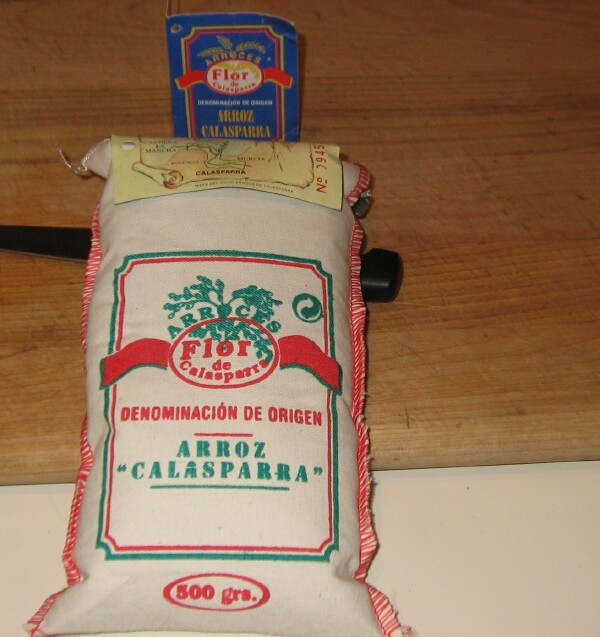
Last night I used store bought chicken stock, an aseptic box of Emeril brand, tonight I made stock from shrimp shells, onion/onion skin, carrot and a little garlic.
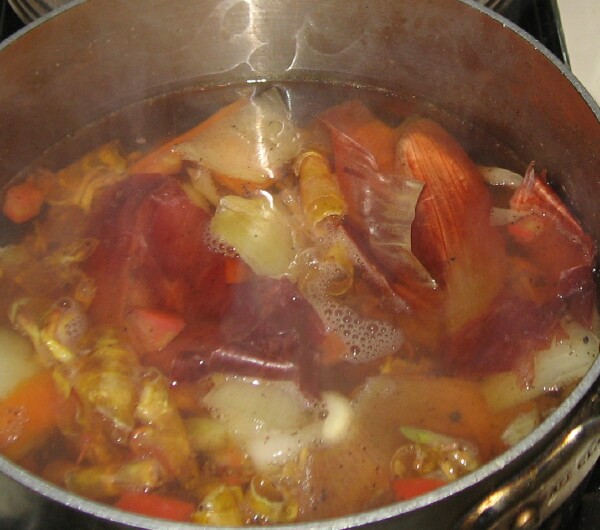
Tonight was all seafood, shrimp, scallop and Chilean sea bass. I also employed a trick Pigmon taught me of giving the fish/scallop a dusting of saffron then olive oil a few hours before using.
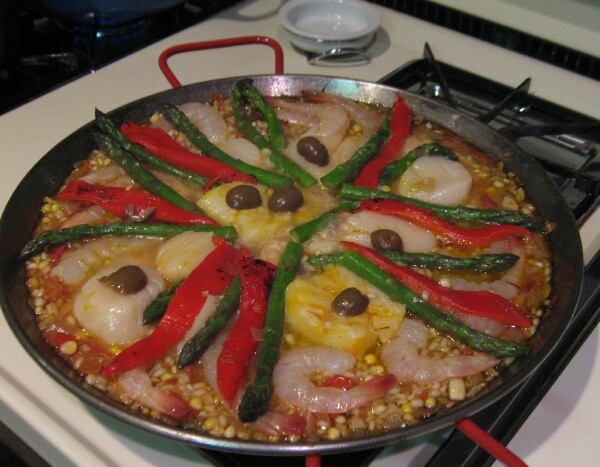
I started the paella the same, saute garlic, onion, tomato. Veg wise I used a small amount of corn cut fresh from the cob, which I probably will not do again, asparagus, which we both liked, a few olives and marinated red pepper. The red pepper was classic/terrific and lent a tangy counterpoint.

Looks like Monday or Wednesday will be my next Paella making opportunity.
Enjoy,
Gary
-
-
Post #10 - April 17th, 2007, 8:06 amHaven't had a chance to make paella in over a week, so this morning I made 'breakfast' paella. Spanish Calasparra, basic sofrito, olive oil and a hint of cayenne for kick, really more to practice my skill, or should I say lack of skill, producing the real reason for paella in the first place, lovely crunchy toasted goodness the Spanish refer to as socarrat.
Starting to get there, but socarrat is mainly in the middle of the pan. I need to work on even distribution.
Paella 4.17.07
-
-
Post #11 - April 17th, 2007, 8:14 amG Wiv wrote:Starting to get there, but socarrat is mainly in the middle of the pan. I need to work on even distribution.
I was watching an episode of Bittman's "Best Recipes in the World" tv show where he was in Valencia making traditional Valencia paella with a young chef. This chef cooks his paella over burning wood and changes the configuration of the fire throughout the process. During the last part of the cooking process, he spreads the coals out, indicating that wider coverage is essential to the process.
Gary,
Have you considered trying it with a heat diffuser?
Best,
Michael
-
-
Post #12 - April 17th, 2007, 8:24 ameatchicago wrote:Have you considered trying it with a heat diffuser?
Michael,
I saw the same episode and I've tried to achieve similar results by moving the pan, quadrant by quadrant, over the flame. I have not tried a heat diffuser, but have one (somewhere) in the back of a cabinet. That's a really good idea, thanks.
I'm plan to start experimenting with live coals, which should prove to be a more even, and intense, heat source. No orange wood on hand though.
Enjoy,
Gary
-
-
Post #13 - April 17th, 2007, 8:33 ameatchicago wrote:Have you considered trying it with a heat diffuser?
This aspect of paella has always bothered me. Paelleras are usually made from very thin metal which is subject to uneven heating. Getting the rice cooked just right without burning the bottom and still having a nice crust all over the bottom is a major challenge.
After much experimentation, I've been extremely pleased with a thick 16" non-stick anodized aluminum Tramontina pan I got a few years ago at Costco. Making perfect paella in it is so easy. I'm all for tradition but have concluded that using traditional paelleras on a conventional stove top makes it a lot harder than it has to be.
Great looking dishes, Gary. You have inspired me to make paella.
Bill/SFNM
-
-
Post #14 - April 17th, 2007, 10:01 amLe Creuset buffet casseroles are great for stovetop as well. The traditional pan works for the traditional method -- outside over wood or charcoal, moving the pan (but not the rice).
Gary, the paellas look great. A couple of variations that you may or may not want to try, based on both tradition and experience. Consider first browning the chicken, crisping the skin in lard or olive oil, then setting aside for incorporation back into the dish with the liquid after frying down the sofrito. For some, unbrowned chicken in an arroz con pollo or paella is sort of like an unbrowned piece of meat in the spaghetti sauce. I also tend to start the sofrito process by frying down some of the chorizo and whatever other cured meat you might be using (a rind from serrano or country ham couldn't hurt, nor could salt pork), without the tomato, garlic, etc. For flavor and color, a shortcut is to buy some chorizos packed in lard (La Unica has several brands, us), then use some of the lard for the sofrito. It will be deeply flavorful with integrated paprika and anatto (but probably not saffron).
As you note, the rice soaks up a lot of flavor, and it's very easy to make a bland paella. Certainly, the cooking liquid needs to be more robust than what you would want to eat straight up. Here, anchovy, dried shrimp, canned shellfish (cuttlefish, eg), shellfish demiglace, etc. come in handy.
One last thing, good paprika and lots of it.
Here is an interesting site with the typically dogmatic/archaic/quirky Spanish approach to paella, a theme that seems to be consistent across borders when it comes to rice dishes.
http://www.lapaella.net/paella-valencia ... iana1.aspx
PS, not traditional, but if I'm cooking a stovetop paella, I always finish it off under the broiler after adding some extra olive oil on top, but before adding the garnishes. More socarrat, and a nice look.
-
-
Post #15 - April 19th, 2007, 6:52 amBill/SFNM wrote:After much experimentation, I've been extremely pleased with a thick 16" non-stick anodized aluminum Tramontina pan I got a few years ago at Costco.
Bill,
The Internet seems to be out of the pan in question, out, plum out, I tell you.
Mummmmmmmmmmmm, plums.....................
I think, as Jeff B suggests, I'll give my Le Creuset gratin a whirl.
Enjoy,
Gary
-
-
Post #16 - April 19th, 2007, 7:06 amJeffB wrote:A couple of variations that you may or may not want to try, based on both tradition and experience.
Jeff,
Thanks much for the paella input I will be incorporating your suggestions into my next paella making adventure. In particular using a Le Creuset and the broiler olive oil trick for additional socarrat.
Enjoy,
Gary
-
-
Post #17 - April 19th, 2007, 10:08 amDid I notice an Italian wine with that paella? You go thru all that work to make a Spanish dish and couldn't serve a nice tempranillo with that? Tsk, tsk! Adrian would be very unhappy.
-
-
Post #18 - April 19th, 2007, 12:38 pmRevrendAndy wrote:You go thru all that work to make a Spanish dish and couldn't serve a nice tempranillo with that? Tsk, tsk! Adrian would be very unhappy.
Ha! Torremoron Tempranillo, 2005, recommended by Adrian himself.
-
-
Post #19 - April 20th, 2007, 8:22 amThis thread has revived the itch to take another crack at paella. I haven't made it in a couple of years. It's always turned out tasty but I still much room for improvement.
I received the The New Spanish Table by Anya von Bremzen last Christmas so I cracked it open to the chapter on paella. There was some discussion on types of rice used. The book says that although Bomba rice seems to be very popular right now, it's not her prefered rice - takes much more liquid, doesn't absorb flavor as well, texture is not as good as other types. One of the recommended rices to use for paella was a little surprising - vialone nano - the Itlalian rice used for making risotto! She said that certain Spanish chefs prefer its texture as well as its ability to absorb a lot of flavor. Anyway, I thought that was interesting.
The good news (for me, at least) is that I have a box of vialone nano in my cupboard!
-
-
Post #20 - April 22nd, 2007, 8:22 pmLTH,
In the interest of fairness I am posting a few pictures of this evenings attempt at paella. I say attempt as it was more poorly executed rice casserole than paella.
I went with a Le Creuset pan and finished under the broiler, as was suggested upthread, but due to poor choices on my part the paella.....I mean rice casserole, was oily and did not develop any socarrat whatsoever.
My main mistake was using fresh Mexican style chorizo, which I took out of the casing, and not degreasing the pan after it's initial fry. The chicken was tasty, I used kosher chicken, and the suggestion of pre browning added to color, flavor and even cooking
I might have developed a layer of socarrat (crisp rice) if I had let it cook on the stove top for another 30-40 minutes, but the rice would have turned to mush and the chicken would have been quite overcooked.
A poor attempt all around.
Rice Casserole, not paella
Very oily, I needed to degrease after the initial saute of fresh Mexican chorizo.
Enjoy,
Gary
-
-
Post #21 - April 23rd, 2007, 8:07 amI have no doubt you will shortly be the Dr. of Paella. I can't wait to try the 5-step method to perfect paella.
-
-
Post #22 - September 7th, 2012, 12:52 pmI'm trying to make paella for the first time - just thought I would revive this thread to see if there was anywhere other than La Unica where people have found Bomba/Calasparra rice. Any help would be appreciated. Thanks!
-
-
Post #23 - September 7th, 2012, 8:12 pmIn my opinion, there are several key ingredients. The saffron and smoked paprika which I get at Spice House. The chorizo which I get at El Mercado and the Calasparra rice which I get online from La Tienda.
http://www.tienda.com/food/products/rc-03.html
Spice House
1941 Central Street
Evanston, IL 60201
(847) 328-3711
El Mercado
3767 North Southport Avenue
Chicago, IL 60613
(773) 477-5020
-
-
Post #24 - September 10th, 2012, 8:23 amSur La Table carries the rice. Brazil Legal carries Paio sausage.
-
-
Post #25 - October 6th, 2019, 2:21 pmHi all, bumping this up to inquire about rice. Serious Eats calls for a short-grain Spanish rice, such as Bomba and Calasparra. Any ideas where I can find either of those styles of rice locally? Or, any alternatives you are happy with? thanks!
-
-
Post #26 - October 7th, 2019, 7:42 amAn “All Departments” search on Amazon for “arborio rice for risotto” (more choices) or “rice for paella” (fewer choices) will show Bomba and Calasparra, as well as others, such as Arborio.
We just used the last of a cloth bag (don’t remember which brand) that was purchased three years ago and the rice seemed just as good as when we first used it.
Some of the offerings shown on the search can be found locally at specialty shops or larger stores – such as the 365 Everyday Value brand at Whole Foods..
-
-
Post #27 - October 7th, 2019, 8:03 amShort grain sushi rice (e.g. pink Kokuho brand rice) works very well as a substitute for paella and risotto rice in my experience. It's much cheaper and widely available.
-
-
Post #28 - October 7th, 2019, 9:12 amI was spoiled for paella by participating in the production of one on a backyard Patio in Barcelona. Having seen it done properly with the pan on an open ring over a propane burner with multiple jets, I don't think it will ever be right on a stove top. Family recipe from a small town and they warned "wasn't quite authentic" but you could have fooled us, and all the authentic ingredients had come right straight from the local market. You could imagine nona stirring it. Sigh, now I'm hungry.
We were recently disappointed by the one we had at Tapas Valencia on S. State street. Same problem that others have described when the pan came it just sort of sat there looking blah, and the rice wasn't properly crunchy on the bottom - and they claim this as one of their specialities.
-
-
Post #29 - October 7th, 2019, 11:17 amLocally, I'd call Publican Quality Meats; I'm fairly sure I've seen it there before.
I've ordered Bomba rice from Amazon. La Tienda is another notable online shop.
-
-
Post #30 - October 8th, 2019, 7:28 amI was at Standard Market in Westmont this weekend, and noted that they had "paella rice" but I didn't check to see the specific nomenclature as I wasn't in the market for any - next time I stop in I'll check to see what it is exactly. Given the quality of the rest of the store I'm pretty confident it'll be the real deal.
BTW, Serious Eats just did a recipe for paella for small groups, using the logic that making it in the traditional size is impractical on indoor burners, or without the right gear. I haven't tried it but plan to sometime this winter!

